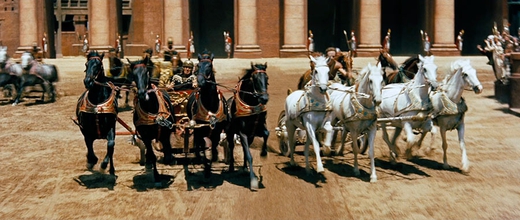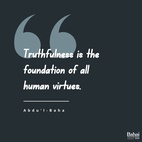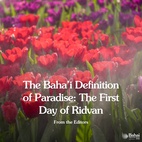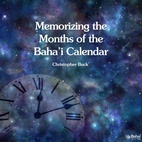The views expressed in our content reflect individual perspectives and do not represent the official views of the Baha'i Faith.
What was it like to be present at the dawning of a new religion?
This question occupied the American writer Lewis Wallace as he conceptualized Ben-Hur, A Tale of the Christ, a bestselling nineteenth century novel. The book amplifies the Christian concept of redemption. Yet perhaps surprisingly, it carries overtones to Baha’i teachings on angels, miracles, and the meaning of Christ’s death.
Just to be clear: this is not about the scintillating 2016 film (a remake of a 1959 movie, which is, in turn, a remake of a 1926 movie). These movies only somewhat resemble the novel.
To form the story, Wallace brilliantly weaves elements from the New Testament and actual quotes from Christ. Of course, Ben-Hur is a work of fiction and should neither be interpreted as supplanting nor supplementing the New Testament. In fact, the Baha’i teachings discourage Baha’is from creating fictitious, artistic representations of any divine messenger. However, Wallace, an ardent Christian, ingeniously provides a plausible narrative about those who experienced Christianity’s birth—who were present at the dawning of a new religion. Through its portrayals of angelic encounters, miraculous cures, and the crucifixion, the book makes one ponder questions such as: Who were the early Christians? What were their lives really like?
The book focuses on a character named Judah Ben-Hur, a young Jewish noble living in Jerusalem who is falsely accused of trying to assassinate the Roman governor. He receives a de facto life sentence as a galley slave. Meanwhile, his mother and sister disappear. After a battle and a shipwreck, he saves the ship’s commander, a prominent Roman, who adopts Ben-Hur. Years later, he makes his way to Antioch—a major Roman city on the eastern Mediterranean Coast—where he becomes a chariot racing champion, defeating his Roman accuser, and wins over allies to his quest for vengeance. Back in Palestine, he becomes a Christian, witnesses the crucifixion, and redeems his family.
Ben-Hur was written in 1880 by Lewis Wallace, a Union Army general who served, among other roles, as U.S. Minister to the Ottoman Empire from 1881-1885—the same period as Baha’u’llah’s residence in Bahji, Palestine, where he wrote Epistle to the Son of the Wolf, the last major work of the Baha’i Faith’s divine messenger. The novel, a blockbuster for its time, outpaced Uncle Tom’s Cabin in sales and topped the all-time U.S. bestseller list until the publication of Gone With the Wind. Pope Leo XII even blessed the book.
Encounter with an Angel
Wallace commences the novel decades before introducing the Hur family with events related to Christ’s birth. A group of highly devout shepherds are mesmerized when an angel appears them to announce Christ’s birth:
“Fear not: for behold, I bring you good tidings of great joy, which shall be to all people.” [said the Angel]
The voice, in sweetness and soothing more than human, and low and clear, penetrated all their being, and filled them with assurance. They rose upon their knees, and, looking worshipfully, beheld in the centre of a great glory the appearance of a man, clad in a robe intensely white; above its shoulders towered the tops of wings shining and folded; a star over its forehead glowed with steady lustre … – Lewis Wallace, Ben-Hur; A Tale of the Christ (all citations from the Kindle Edition.)
This fictional encounter relates to Abdu’l-Baha’s metaphoric description of empyrean beings:
The meaning of “angels” is the confirmations of God and His celestial powers. Likewise angels are blessed beings who have severed all ties with this nether world, have been released from the chains of self and the desires of the flesh, and anchored their hearts to the heavenly realms of the Lord. These are of the Kingdom, heavenly; these are of God, spiritual; these are revealers of God’s abounding grace; these are dawning-points of His spiritual bestowals. – Abdu’l-Baha, Selections from the Writings of Abdu’l-Baha, p. 81.
In this sense, the angel is both a confirmation of the shepherds’ unwavering faith and a dramatic being.
Miraculous Cures
After his condemnation, Ben-Hur’s sister and mother are cast into prison. When a new governor releases them after years of incarceration, they face the shocking realization that they have become lepers, and are banished to a leper colony. Christ miraculously cures them amidst his celebrated Palm Sunday entry into Jerusalem:
The miracle began. There was first in the hearts of the lepers a freshening of the blood; then it flowed faster and stronger, thrilling their wasted bodies with an infinitely sweet sense of painless healing. Each felt the scourge going from her; their strength revived; they were returning to be themselves … – Lewis Wallace, Ben-Hur; A Tale of the Christ.
But do such miracles matter? The Baha’i writings teach us that miracles are only to be used as proof of the manifestation of God’s power for those immediately present. Citations of miracles in books are not proof of the power of a divine messenger. Moreover, eventually we all deteriorate physically, so extraordinary events such as this are short term, temporary and temporal:
These outward miracles are of no importance to the followers of truth. For example, if a blind man is made to see, in the end he will again lose his sight, for he will die and be deprived of all his senses and faculties. Thus, causing the blind to see is of no lasting importance, since the faculty of sight is bound to be lost again in the end. And if a dead body be revived, what is gained thereby, since it must die again? – Abdu’l-Baha, Some Answered Questions, newly revised edition, p. 114.
Crucifixion and Redemption
At the close of the novel, Ben-Hur is present at Christ’s crucifixion. Ben-Hur offers Christ wine in the latter’s dying moments:
The face [of Christ] then plainly seen by Ben-Hur, bruised and black with blood and dust as it was, lighted nevertheless with a sudden glow; the eyes opened wide, and fixed upon some one visible to them alone in the far heavens; and there were content and relief, even triumph, in the shout the victim gave. “It is finished! It is finished!” – Lewis Wallace, Ben-Hur; A Tale of the Christ.
Baha’u’llah highlights the potency of Christ’s sacrifice with the crucifixion:
Know thou that when the Son of Man yielded up His breath to God, the whole creation wept with a great weeping. By sacrificing Himself, however, a fresh capacity was infused into all created things … – Baha’u’llah, Gleanings from the Writings of Baha’u’llah, p. 85.
As an example of such quickening spiritual power, at the close of Ben-Hur, the protagonist and his family and his family are living in Italy. The Roman Emperor Nero is persecuting Christians, and Hur, his friends, and family journey to Rome to build the church and catacombs, a refuge for early Christians, with Hur’s fortune.
What Stories Remain?
Though literary, the story of Ben-Hur and his family causes one to consider, in the larger picture, how many true-to-life inspirational stories of early believers—in Christianity, Islam, Buddhism, or any other Faith—lie forever unknown? Though they aren’t fictional blockbusters like Ben-Hur, in the Baha’i Faith, we are fortunate to have a treasure trove of actual historic documents about the lives of early believers. The most notable is The Dawn Breakers, an account of the heroes of the Babi religion—the forerunner to the Baha’i Faith. The book recounts the spellbinding stories of Tahirih, the martyrs of Fort Tabarsi, the Bab’s heartless captor who later became a believer, and the tens of thousands who witnessed the martyrdom of the Bab, among numerous other episodes.
Nowadays, Baha’is worldwide are chronicling a legion of stories from people of all backgrounds impacted by the spiritual forces Baha’u’llah released into the world, just as Christ did two millennia ago. Thousands of examples of such narratives are on this very website. Christ, Baha’u’llah, and other divine luminaries enable the promise of the “… changeless Faith of God, eternal in the past, eternal in the future …” – Baha’u’llah, The Most Holy Book, p. 85.
What will your chapter be?

















Comments
Sign in or create an account
Continue with Facebookor